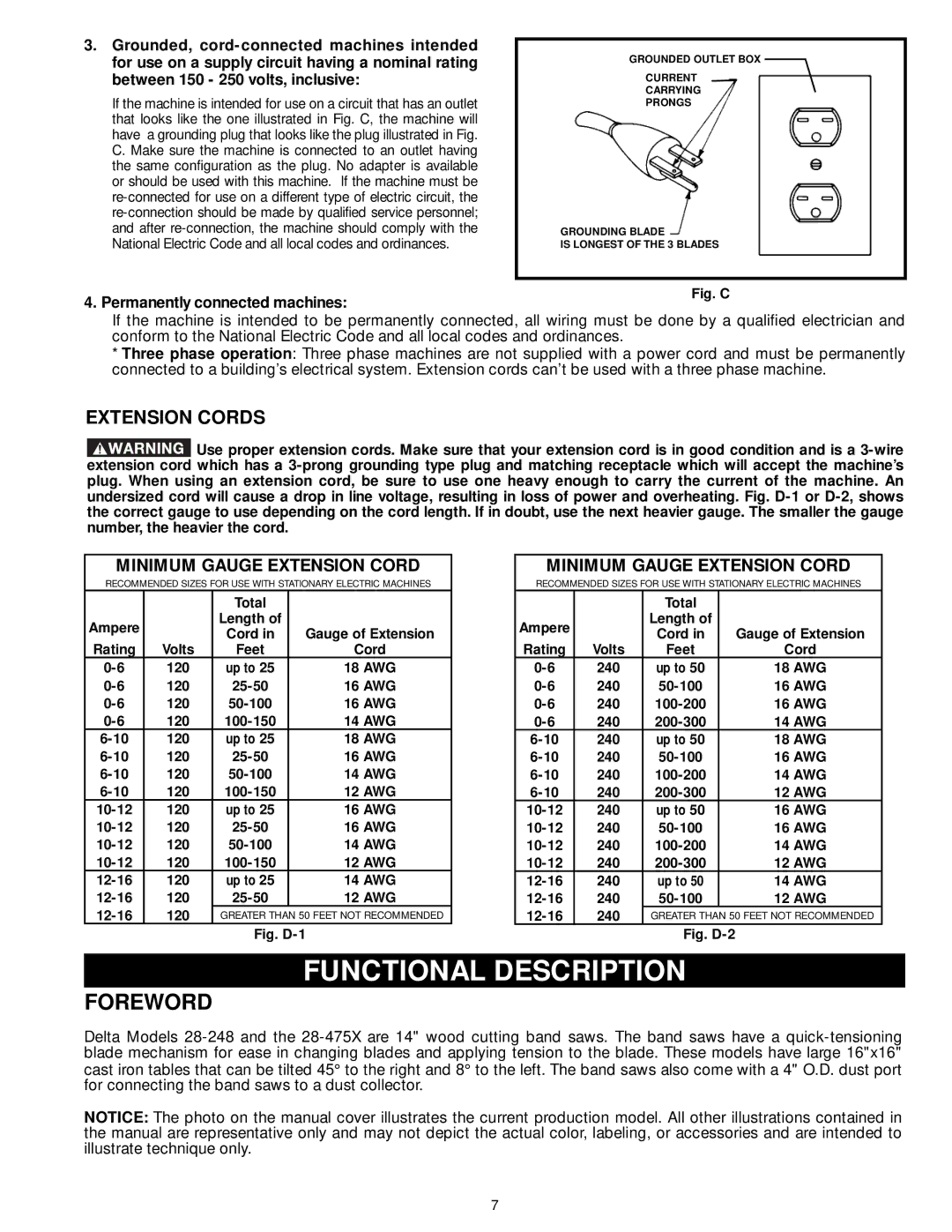
3.Grounded,
If the machine is intended for use on a circuit that has an outlet that looks like the one illustrated in Fig. C, the machine will have a grounding plug that looks like the plug illustrated in Fig. C. Make sure the machine is connected to an outlet having the same configuration as the plug. No adapter is available or should be used with this machine. If the machine must be
4.Permanently connected machines:
GROUNDED OUTLET BOX
CURRENT
CARRYING
PRONGS
GROUNDING BLADE
IS LONGEST OF THE 3 BLADES
Fig. C
If the machine is intended to be permanently connected, all wiring must be done by a qualified electrician and conform to the National Electric Code and all local codes and ordinances.
*Three phase operation: Three phase machines are not supplied with a power cord and must be permanently connected to a building’s electrical system. Extension cords can’t be used with a three phase machine.
EXTENSION CORDS
![]() Use proper extension cords. Make sure that your extension cord is in good condition and is a
Use proper extension cords. Make sure that your extension cord is in good condition and is a
MINIMUM GAUGE EXTENSION CORD
RECOMMENDED SIZES FOR USE WITH STATIONARY ELECTRIC MACHINES
|
| Total |
|
Ampere |
| Length of |
|
| Cord in | Gauge of Extension | |
|
| ||
Rating | Volts | Feet | Cord |
120 | up to 25 | 18 AWG | |
120 | 16 AWG | ||
120 | 16 AWG | ||
120 | 14 AWG | ||
120 | up to 25 | 18 AWG | |
120 | 16 AWG | ||
120 | 14 AWG | ||
120 | 12 AWG | ||
120 | up to 25 | 16 AWG | |
120 | 16 AWG | ||
120 | 14 AWG | ||
120 | 12 AWG | ||
120 | up to 25 | 14 AWG | |
120 | 12 AWG | ||
120 | GREATER THAN 50 FEET NOT RECOMMENDED | ||
|
| Fig. | |
MINIMUM GAUGE EXTENSION CORD
RECOMMENDED SIZES FOR USE WITH STATIONARY ELECTRIC MACHINES
|
| Total |
|
|
Ampere |
| Length of |
|
|
| Cord in |
| Gauge of Extension | |
|
|
| ||
Rating | Volts | Feet |
| Cord |
240 | up to 50 |
| 18 AWG | |
240 |
| 16 AWG | ||
240 |
| 16 AWG | ||
240 |
| 14 AWG | ||
240 | up to 50 |
| 18 AWG | |
240 |
| 16 AWG | ||
240 |
| 14 AWG | ||
240 |
| 12 AWG | ||
240 | up to 50 |
| 16 AWG | |
240 |
| 16 AWG | ||
240 |
| 14 AWG | ||
240 |
| 12 AWG | ||
240 | up to 50 |
| 14 AWG | |
240 |
| 12 AWG | ||
240 | GREATER THAN 50 FEET NOT RECOMMENDED | |||
|
| Fig. |
| |
FUNCTIONAL DESCRIPTION
FOREWORD
Delta Models
NOTICE: The photo on the manual cover illustrates the current production model. All other illustrations contained in the manual are representative only and may not depict the actual color, labeling, or accessories and are intended to illustrate technique only.
7
